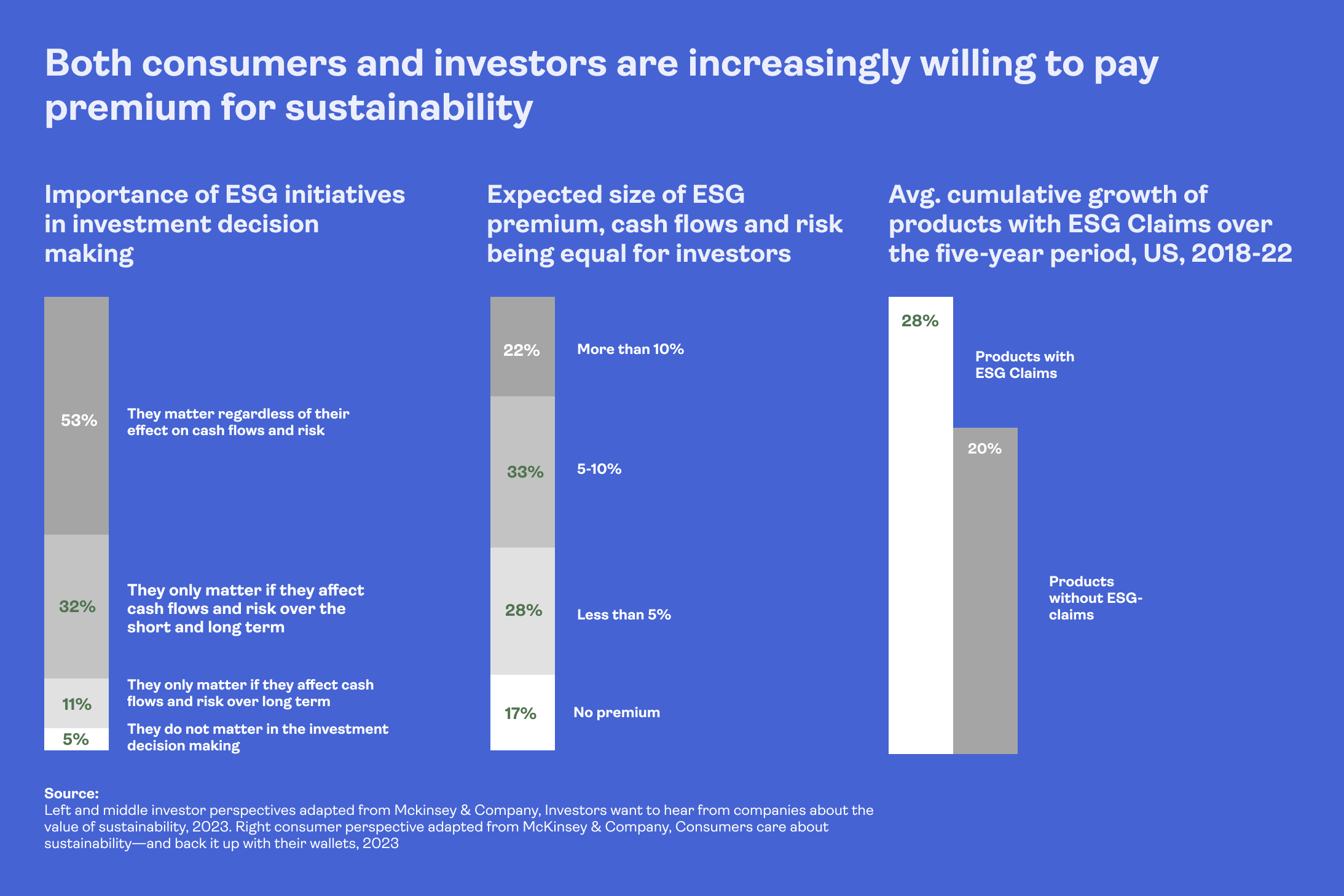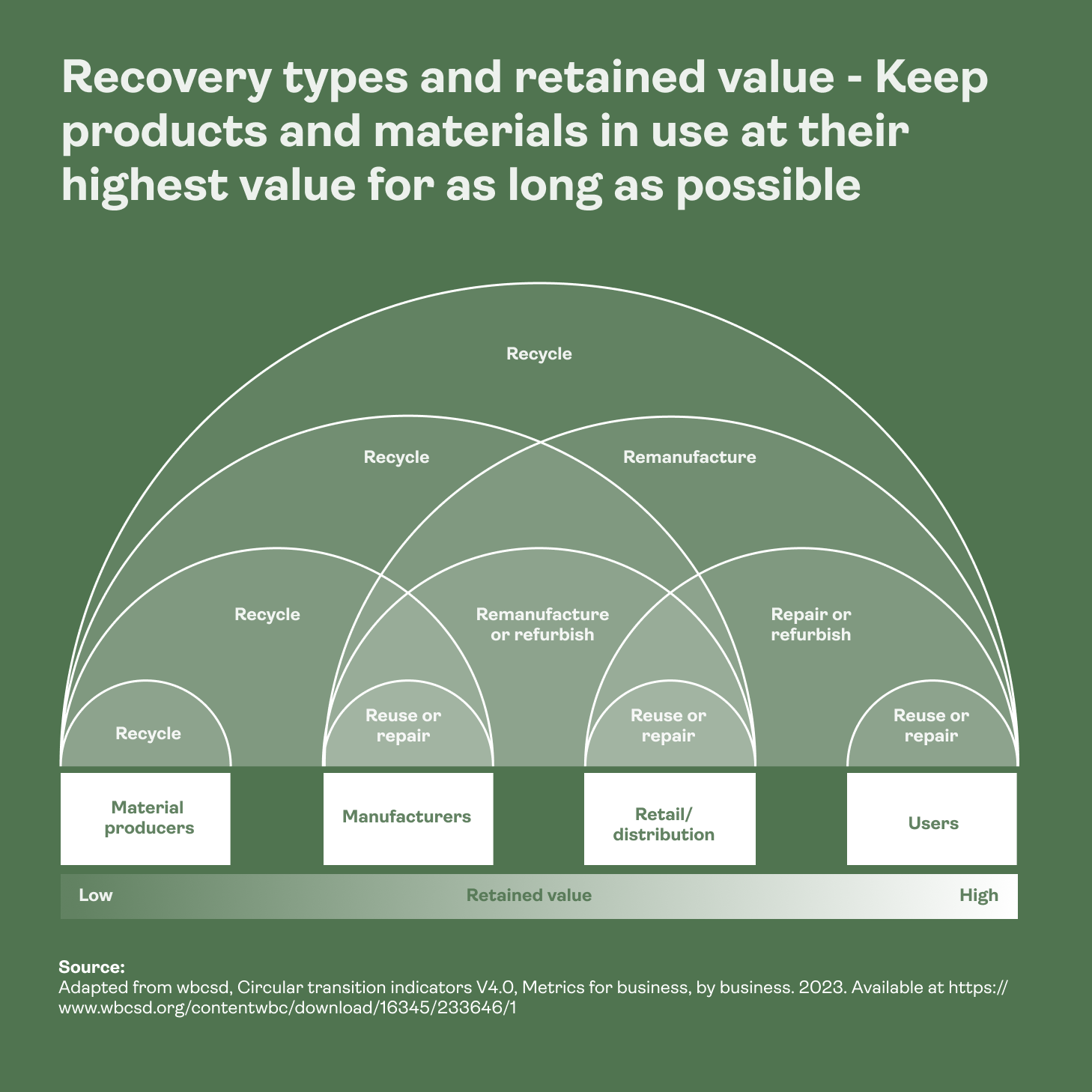20 October 2023
Business Design for the Future - Your Business's Path to Circular Solutions
Start your journey towards circular solutions and be a pioneer in designing a sustainable and prosperous future
Emma-Sofie Kukkonen
Head of Design Practice
20 October 2023
Business Design for the Future - Your Business's Path to Circular Solutions
Start your journey towards circular solutions and be a pioneer in designing a sustainable and prosperous future
Emma-Sofie Kukkonen
Head of Design Practice
In today's world, the urgency of embracing circular solutions for your business cannot be overstated. The linear "take-make-waste" model is no longer viable in a world where environmental issues, climate change, and resource depletion have reached a tipping point (1). Circular business design is not just a “right thing to do”; it's a necessity for future-proofing your business. In this blog post, we'll explore the imperative of circularity, and the approaches and steps you can take to make your business thrive in the future of circular economy.
The future belongs to circular and sustainable businesses. Customers, investors, (2,3) and even regulatory bodies are increasingly favoring companies that demonstrate their commitment to sustainability. To secure your place in this future, you must act now. Transforming one's business might sound like a daunting task but it doesn't mean worse business. It is an opportunity to future-proof your business and innovate towards a prosperous future.

Products with ESG-related claims boasted a 1.7 percentage-point advantage—a significant amount in the context of a mature and modestly growing industry—over products without them (2).
Sources:
1. IPCC, 2018: Summary for Policymakers. In: Global Warming of 1.5°C. An IPCC Special Report on the impacts of global warming of 1.5°C above pre-industrial levels and related global greenhouse gas emission pathways, in the context of strengthening the global response to the threat of climate change, sustainable development, and efforts to eradicate poverty [Masson-Delmotte, V., P. Zhai, H.-O. Pörtner, D. Roberts, J. Skea, P.R. Shukla, A. Pirani, W. Moufouma-Okia, C. Péan, R. Pidcock, S. Connors, J.B.R. Matthews, Y. Chen, X. Zhou, M.I. Gomis, E. Lonnoy, T. Maycock, M. Tignor, and T. Waterfield (eds.)]. Cambridge University Press, Cambridge, UK and New York, NY, USA, pp. 3-24, doi:10.1017/9781009157940.001. https://www.ipcc.ch/sr15/chapter/spm/
2. McKinsey & Company, 2023. Consumers care about sustainability—and back it up with their wallets, Accessed 20.10.2023 https://www.mckinsey.com/industries/consumer-packaged-goods/our-insights/consumers-care-about-sustainability-and-back-it-up-with-their-wallets
3. Mckinsey & Company, 2023. Investors want to hear from companies about the value of sustainability. Accessed 20.10.2023 https://www.mckinsey.com/capabilities/strategy-and-corporate-finance/our-insights/investors-want-to-hear-from-companies-about-the-value-of-sustainability
Circular approachces
There are several circular approaches you can employ to transform your business:
Product Life Extension: Focus on designing products that are durable, repairable, and upgradable, increasing their lifespan and reducing waste.
Reuse and Refurbishment: Develop systems for reusing and refurbishing products, saving resources and reducing waste.
Recycling and Remanufacturing: Implement processes to recycle materials and remanufacture products to keep materials in circulation.
Sharing and Collaborative Consumption: Explore business models that encourage sharing and collaborative consumption, reducing the need for individual ownership and excess production.
Digitalization and Data Optimization: Leverage digital technologies to optimize your operations, reduce waste, and improve resource efficiency.

Ways to Get Started on Your Circular Journey
Transforming one's business might sound like a daunting task but it doesn't mean worse business. It is an opportunity to future-proof your business and innovate towards a prosperous future through these 5 steps.
Map Your Product Portfolio and Value Chain: Start by mapping your entire value chain to identify areas where circular approaches can be integrated. This will help you understand the flow of materials and resources within your business.
Identify Suitable Circular Strategy: Once you've mapped your value chain, identify the most suitable approach for your business. This may involve a combination of approaches tailored to your unique circumstances.
Develop and Test a Business Model: Design a circular business model that aligns with your chosen approach. Test it to ensure it is viable and sustainable. A well thought-out circular business model is often also commercially attractive. E.g. extending product life can enable shifting more to usage-based pricing, or improved reuse can drive down material costs.
Ensure True Impact on Circular Flows: It's not enough to implement a circular approach; you must also monitor and measure its impact on circular flows. Ensure that you are genuinely reducing waste and enhancing resource efficiency. Before moving to piloting do a quick check by calculating based on the data available how much your solution reduced inflow of virgin materials and outflow to waste and keep an eye on the net impact by checking impact on emissions.
Pilot and Scale: Begin with a pilot project to test your circular business model. Once you've refined and proven its effectiveness, scale it up across your business operations.
In conclusion, the transition to circular solutions is a critical imperative for businesses in the 21st century. The linear "take-make-waste" model is no longer tenable in a world where sustainability and circularity are the way forward. Embracing circularity not only secures your place in the future but also opens the doors to innovation, cost savings, and enhanced environmental and social responsibility.
The time to act is now. Start your journey towards circular solutions and be a pioneer in designing a sustainable and prosperous future.
The best way to predict the future is to make it happen. Together, we can create a sustainable and regenerative future.
Let's talk about how to make this happen
We help you set the foundation and grow into becoming true business leaders in vast sustainability transformations.
Mia Folkesson
Managing Partner
mia@impaktly.com
Let's talk about how to make this happen
We help you set the foundation and grow into becoming true business leaders in vast sustainability transformations.
Mia Folkesson
Managing Partner
mia@impaktly.com